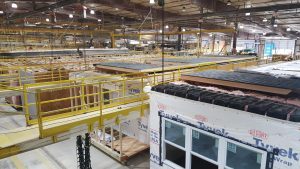You Have a Choice


Have you ever stopped to think about how many choices you have to make on a daily basis? From the minute you wake up you are faced with an enormous amount of options. What to wear, what to eat, where will we go, what time will we leave, etc. The same thing happens when you build a home. What style, what floor plan, what type of flooring, what color flooring, etc. But, you also have a choice on how to build your home. Today, building systems are improving home building. Many builders “dabble” with building systems. They use roof trusses or floor trusses but they don’t take full advantage of the possibility that they could build your whole house better, not just a few parts. Why would you choose a builder that doesn’t give you the choice to have your home built a better way?
You Have the Power to Make the Right Choice
Many homebuyers don’t even ask how their home will be built. Or, when they discuss it with a builder they hear things like, “I have to,” or, “That’s the way we build, there isn’t a choice.” But that’s simply not true. It’s a victim mentality that says I HAVE to do something. Reality says that we CHOOSE what we do. Don’t be a victim by letting your builder choose to use outdated building techniques to build your new home.
You can choose to have a home built a better way. With modular construction, your home is built indoors and away from the sun’s rays, the rain, and the snow. It is always summer in the factory! Building indoors means your home is built under environmentally controlled conditions. But building indoors means much more than just protecting your home from the weather. A healthy living environment is promoted for you and your family by reducing the risk of mold and mildew growth.
Choose Design Flexibility – Create Beautifully Designed Homes
With advancements in modular construction, you can build virtually any home plan that can be efficiently divided into modules. They can then be built using indoor off-site construction and assembled onsite. For example, you can start with home plans from most home plan sites that were created by many architects and designers. These are plans that can be “modularized” and built using advanced modular construction.
Choose Energy Efficiency – Save Money and Increase Comfort
Because modular construction concentrates the manufacturing of many homes in one location it means that processes can be applied consistently. Tight, indoor construction processes mean healthier living for you and your family. Modular construction is a building system. By using a consistent system to build your home, details that are often overlooked in traditional construction are managed and done properly in a factory environment. Building a home to a high-performance standard is almost a by-product of building indoors.
Choose Resiliency – The Safety of Modular Construction to Protect You and Your Family
The term resiliency refers to a home’s ability to withstand and recover from natural disasters like hurricanes, earthquakes, tornadoes, wildfires, and flooding. It also can extend to events like severe winter storms. Modular homes are built strong. The basis for modular construction is to build a home that meets or exceeds building code. However, the modules that make up a modular building are built off-site and transported to that site. The effort of getting them from a factory to the building site is about the equivalent of surviving a hurricane and an earthquake before a module ever reaches a job site.
Choose Value – Get the Cost Efficiency that Indoor Modular Construction Provides
The process of modular construction is the equivalent of construction efficiency. Efficiency means planning the entire construction process. The process builds efficiency in many ways. They include: better use of material, buying materials in bulk, and better construction planning.
Don’t Be Fooled
 A key belief for many homebuyers is that they have choice poverty. They’ve been trained to believe in the notion that there’s simply nothing they can do and that they are controlled by the builder’s choice. That belief leaves people feeling powerless. Don’t let them make you play into their confusion. One of the biggest stumbling blocks in the growth of the modular home industry has been the misunderstanding of exactly what modular construction is or isn’t. Much of this has been driven because of modular construction’s affordable housing cousin, the mobile home (manufactured home). While everyone supports the ability to provide affordable homes, modular construction takes a different path to achieve a level of affordability that can’t be achieved with traditional onsite construction.
A key belief for many homebuyers is that they have choice poverty. They’ve been trained to believe in the notion that there’s simply nothing they can do and that they are controlled by the builder’s choice. That belief leaves people feeling powerless. Don’t let them make you play into their confusion. One of the biggest stumbling blocks in the growth of the modular home industry has been the misunderstanding of exactly what modular construction is or isn’t. Much of this has been driven because of modular construction’s affordable housing cousin, the mobile home (manufactured home). While everyone supports the ability to provide affordable homes, modular construction takes a different path to achieve a level of affordability that can’t be achieved with traditional onsite construction.
Manufactured (think mobile) homes achieve affordability by being built to a different building code than either modular homes or site-built homes. The Federal government created a prescriptive code known as the HUD code for manufactured home construction. This means that as long as an engineer certifies a home to a required performance level (i.e. can withstand 90 mph winds) then the home meets that code. It doesn’t matter if it achieves it with 2”x2” construction and tape.
Both site-built homes and homes built using modular (off-site) construction must follow the International Residential Building code (or your state’s version of it). This code is descriptive. It will state how a home built in a specific wind zone must be constructed. For instance, it could state that the home’s walls must be built with #2 SYP 2”x6” studs and sheathing must be attached with 8p ring shank nails placed 6” apart on studs and 3” apart on top and bottom plates.
Homes built using modular construction actually take this one step further. They have to be built in sections (modules), transported to the home site on today’s highway system and then be lifted with a crane. The home is actually constructed in a way that builds in resilience. In addition, the factory construction method means the construction of the home took advantage of the efficiencies of manufacturing. Depending on the area of the country, the home plan, and the options selected; a modular home can be better valued than its site-built competition by 5% – 15% or more.
The Right Choice is a Home Built Using Modular Construction
Residential home construction today is a gauntlet. The lack of skilled labor, the cost of materials, the timeframe to build a home and the regulatory hurdles all add up. Home construction is difficult. Smart builders and smart homeowners are learning about the key advantages of modular construction. The custom home building industry is one of the last industries to embrace the advantages that every other major industry and product has discovered… factory production. The changing construction labor force and demand for better and consistent quality are now driving the entire custom home building industry to find a better solution. Homebuyers and home builders alike are learning that Modular Means More!
The post You Have a Choice appeared first on Impresa Modular.




